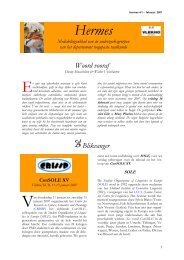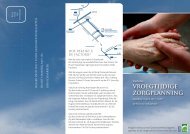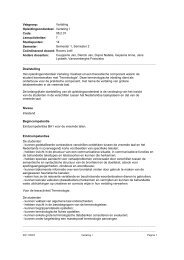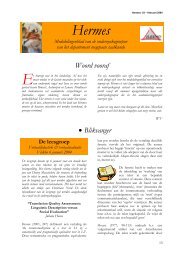HUB RESEARCH PAPER - Hogeschool-Universiteit Brussel
HUB RESEARCH PAPER - Hogeschool-Universiteit Brussel
HUB RESEARCH PAPER - Hogeschool-Universiteit Brussel
You also want an ePaper? Increase the reach of your titles
YUMPU automatically turns print PDFs into web optimized ePapers that Google loves.
Process consultation revisited 11<br />
Relational practices are “multi-voiced” (Engeström, 2001), since actors engage in<br />
relational practices from their membership to occupational cultures (Schein, 1996) and<br />
participation in communities of practice (Lave & Wenger, 1991; Wenger, 1998). Hence,<br />
different accounts and perspectives have to taken into account.<br />
An occupational culture is conceived as a ‘state-of-mind’: the shared assumptions, values<br />
and norms based on members’ similar educational backgrounds, formal training and similar<br />
practical experiences in pursuing the occupation (Schein, 1996, 2003a). Occupational cultures<br />
typically form around the functional units and hierarchical levels of an organization but also exist<br />
beyond the organization as occupational communities (of executives, operators, engineers, etc.).<br />
Schein (1996) states that until occupational cultures “discover that they use different languages<br />
and make different assumptions about what is important, and until they learn to treat the other<br />
cultures as valid and normal, organizational learning efforts will continue to fail” (p. 18).<br />
Actors also participate in communities of practice (Lave & Wenger, 1991; Wenger,<br />
1998). Lave and Wenger (1991) have conceptualized apprenticeship as legitimate peripheral<br />
participation in a community of practice. A community of practice is a group of people “who<br />
share a concern, a set of problems, or a passion about a topic, and who deepen their knowledge<br />
and expertise in this area by interacting on an ongoing basis” (Wenger, McDermott & Snyder,<br />
2002, p. 4). Following Bouwen (1998), actors constitute through continuous relational practices<br />
“groups of members, which serve as basis for social validation, social identity, and continuity”<br />
(p. 306). A community of practice is an intrinsic condition for the existence of knowledge and<br />
learning, because it provides the necessary support for making sense of context and history.<br />
Following Lave and Wenger (1991), a community of practice can be delineated by analyzing its<br />
reproduction cycles and its relations. It has a particular language, which is an important element







